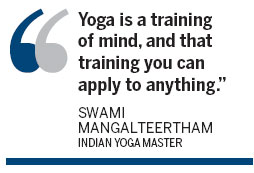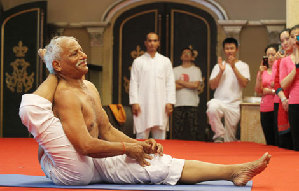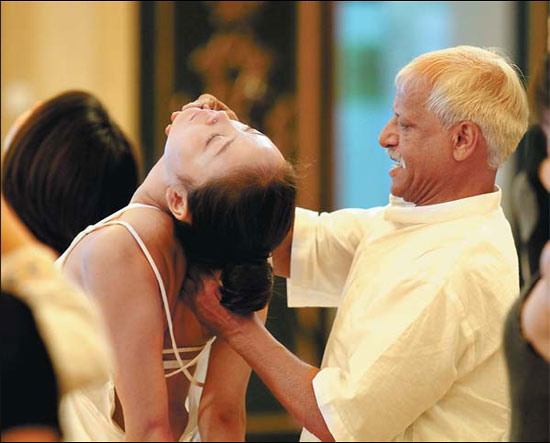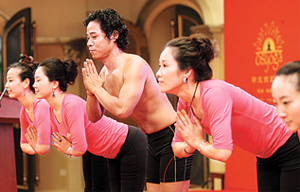Breathe deep, this is the real thing
|
Indian yoga master Bal Mukund Singh teaches students how to do yoga properly at the 2013 China-India Yoga Week in Beijing. Zhu Xingxin / China Daily |
Indian yoga master Swami Mangalteertham was in Beijing recently for the 2013 China-India Yoga Week, where he said he wants to eliminate "junk yoga" in China.
The yoga week was supported by the Indian embassy, and the presence of the invited Indian masters attracted hundreds of Chinese yoga lovers.
"Today, in many places, even in India, yoga is served like junk food, not real food. It does not nourish your body," Mangalteertham says.
"Real yoga helps you to grow physically, mentally, emotionally and spiritually, but junk yoga does not."
The masters taught the learners onsite how to breathe and concentrate while doing yoga, and how to avoid injuries.
In classic yoga, there are eight integrated facets: the universal principles, personal observances, asana or body postures, breathing exercise and the control of prana or energy, control of the senses, concentration, meditation, and union with nature and the divine.
Every part is indispensable, Mangalteertham says.

The yoga style most well known is Hatha yoga or asana - the practice of moving the body into postures which can improve health, strength, balance, flexibility and body shape.
But, asana on a deeper level is a tool to calm the mind. And yoga practitioners concentrate on the movement to meditate, as well as to control the flow of energy in the body to feed the spirit.
"Yoga is a training of mind, and that training you can apply to anything," Mangalteertham says.
The prevailing emphasis on the physicality of yoga is the result of commercialization, which opposes the principles of the traditional practice and is not good for yoga students, says N.K. Singh, who represents the Bapu Nature Cure Hospital & Yogashram in New Delhi, India.
Singh recently established a classic yoga studio in Beijing, because he finds too many yoga instructors in China unqualified to teach asana, let alone meditation.
Li Jin, a Xinjiang native, met Singh in India in 2005, and they are partners in the Beijing ashram.
Li used to be skeptical because she had gotten hurt while learning with her yoga teacher, but her encounter with Singh changed her mind. "Yoga is not only about body postures, but more importantly, the inner awareness and peace one gets when one concentrates and meditates."
Mangalteertham agrees.
"If you practice yoga, you should practice all the eight parts. That is real yoga."
 |
|
| Don't stretch yourself |




















